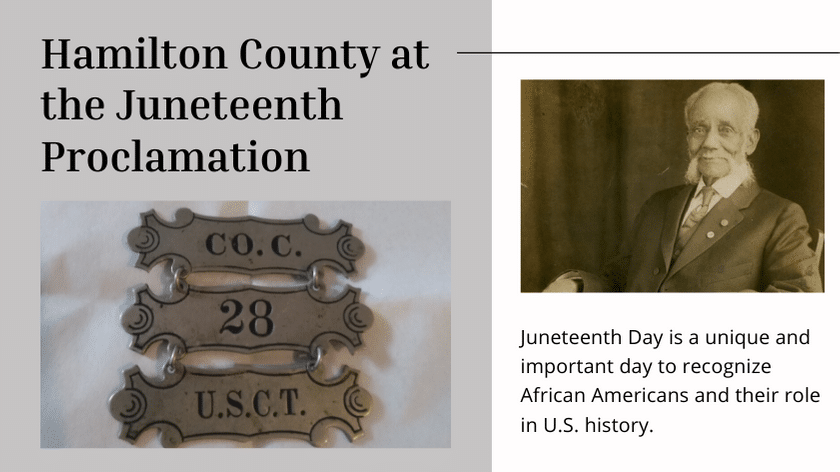Written by Hamilton County Historian, David Heighway with special thanks to Lezli Davis for new information and much of the research on individuals
Juneteenth Day is a unique and important day to recognize African Americans and their role in US history. Its roots lie in the celebrations that occurred in Texas when General Gordon Granger issued General Order No. 3 on June 19th, 1865, which announced the proclamation that had ended slavery in the rebelling states. Although this may seem to have little connection to Hamilton County, Indiana, if we look at period newspapers and the official reports, there may be a direct tie.
It involves the 28th United States Colored Troops, which was organized in Indiana in early 1864. Several Hamilton County men joined the regiment, including members of the families that lived at Roberts Settlement. Like all USCT units, anyone who had the rank of lieutenant or above was white.

Manual of Arms from the Roberts Settlement collection at the Library of Congress.
The regiment saw serious action, including the Siege of Petersburg which ran from June 1864 to April 1865. They were at the Battle of the Crater on July 30, 1864, and had nearly half the men killed or wounded. The regiment was absorbed into the 25thCorps formed in December 1864 under Major General Godfrey Weitzel, which was made up solely of African American soldiers. They were at the surrender of Richmond, and were one of the regiments who marched in on April 4, 1865.
After the Confederacy surrendered and the war ended, much of the 25th Corps, (including the 28th), was sent to Texas. This action was actually unrelated to the war. The French Empire, ignoring the Monroe Doctrine, had occupied Mexico with the intent of taking it over. This is known as the French Intervention and was opposed by Mexicans led by Benito Juarez. United States troops were sent to Texas to guard the border and help get supplies to the Mexicans. In addition, the French were being joined by ex-Confederates.

Military Map from the Roberts Settlement collection at the Library of Congress.
The troops of the 25th Corps were supposed to land at Brazos Santiago, but there was no harbor and no boats to transfer them from the ships to the land. Instead they went to Galveston harbor on June 18th for the ships to take on coal and fresh water. General Granger arrived in Galveston on the morning of the 19th and immediately sent a report to General Sheridan about the situation and asked for boats to be sent that could transfer the troops and their equipment to shore.
Then Granger began issuing General Orders, including Order No. 3. The next day, he left for Houston to secure that city. A reporter for the New York Tribune sent a message to the paper dated June 20 that said, “Galveston is now occupied by colored troops, constituting a provost guard [military police] for the enforcement of law and order.”
We can’t be certain that the 28th was at Galveston. The reporter also said that some of the transport ships were at Galveston, and others were at Brazos Santiago or Mobile Bay. Eventually all of the soldiers got to Brazos Santiago, and then from there to Corpus Christi on July 1. After serving its time, the 28th was mustered out in November at Corpus Christi.
If some of the men of the 28th were at Galveston, they may have had the extraordinary opportunity to be among the first Union troops into Richmond and to also hear Granger’s proclamation. The idea that Hamilton County African Americans had been at both the fall of Richmond and the first Juneteenth Day is a great story to tell.
Working with the official records, we have created a list of Hamilton County men who could have been in the right place at the right time.

A picture of Alfred Scott courtesy of Dana Hughes.
28th USCT
- Company A – Pvt. Lorenzo Brooks
- Company B – Pvt. Gooding T. Newsom (wounded at Battle of Hatcher’s Run, Petersburg)
- Company C – Sgt. Alfred D. Carter
- Corp. Calvin Brooks
- Corp. Junius B. Roberts
- Corp. Joseph B. Winburn
- Company D – Pvt. Alfred Scott
- Company E – Pvt. William Brown
- Pvt. George W. Dempsey
- Pvt. Samuel Mathews
- Pvt. Stephen Outland
- Company F – Pvt. Solomon Dawson (wounded at Petersburg)
- Pvt. Joseph Hampton
- Pvt. John Mitchell
- Company H – Capt. Thomas J. Gray (white commander of the company)
- Company I – Corp. George W. Sweat

Alfred Scott’s Grand Army of the Republic (GAR) badge courtesy of Dana Hughes.
There were other possible Hamilton County witnesses in other USCT regiments that had gone to Texas.
8th USCT
- Pvt. William Bailey Co. A
- Pvt. George Hord Co. I
- Pvt. John Hord Co. D
- Pvt. Richard Roberts Co. H
Others
- Sgt. John S. Newsom [as Jasper Newton] Co. G 31st USCT
- Pvt. John Lucas [as John Logan] Co. K 109th USCT
- Pvt. George Whitman Co. A 115th USCT
Juneteenth 2021 Book Selections
Acknowledgements
- Thanks to Lezli Davis for new information and much of the research on individuals.
- Photographs of Alfred Scott and his GAR badge, courtesy of Dana Hughes.
- Map and manual of arms belonging to Junius B. Roberts from the Roberts Settlement collection at the Library of Congress.
